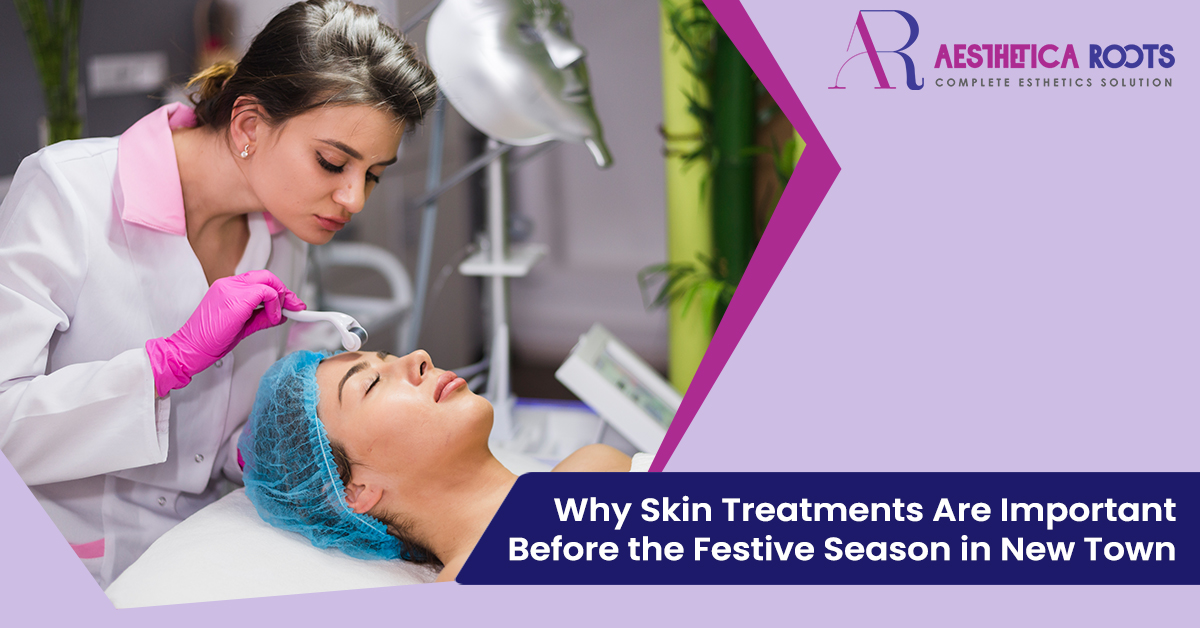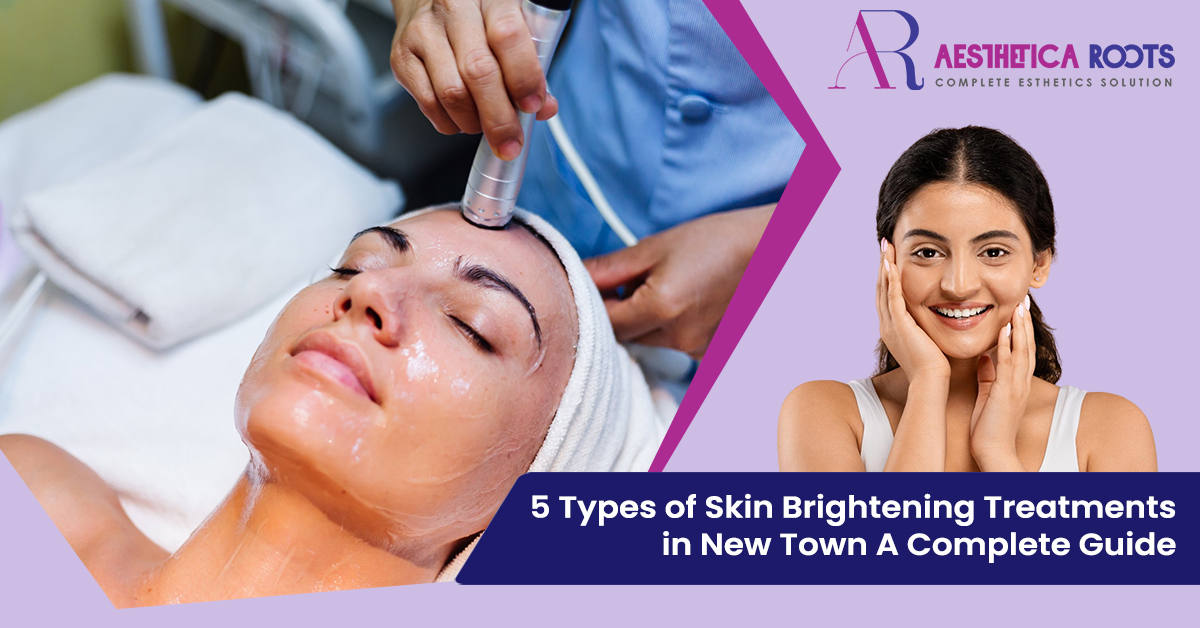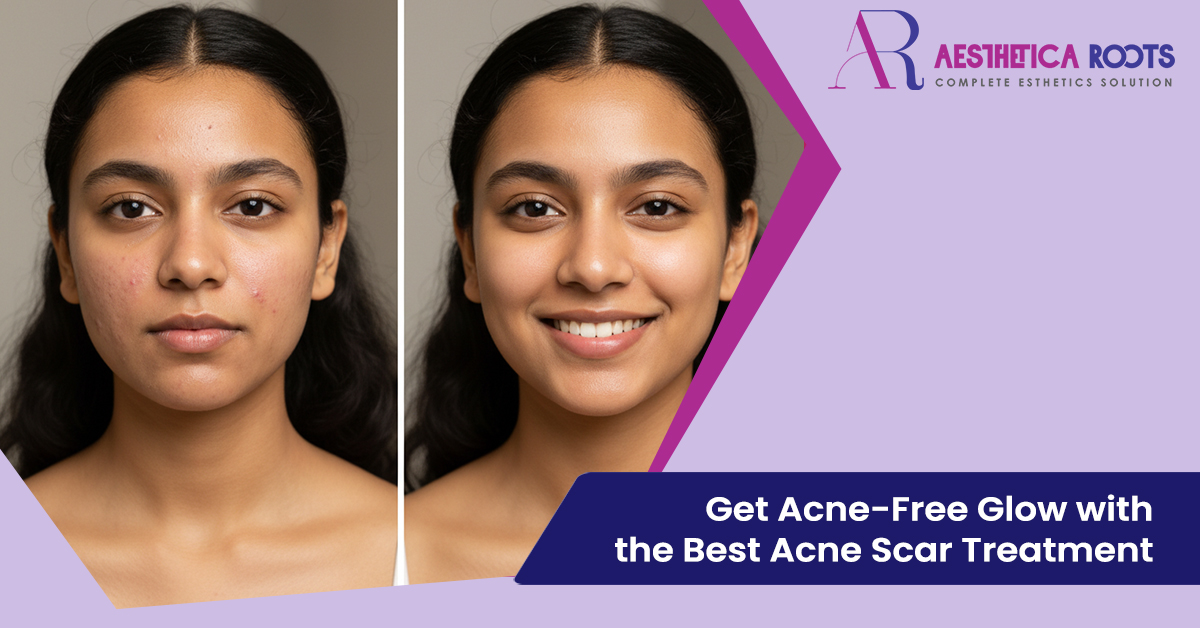
Clinic Opening Hours
We are open to help with your skin and hair care needs. Visit us during our working hours or book an appointment anytime.
| Every Day | - | 10:00 AM - 7:30 PM |
Best Skin & Hair Treatment Clinic in New Town
Aesthetica Roots is one of the top skin and hair treatment clinics in New Town and Salt Lake, offering advanced aesthetic and dermatology solutions. Our highly experienced doctors and specialists provide all types of skin and hair treatments like laser treatment, skin rejuvenation, hair restoration, and anti-ageing therapies etc., in the New Town.
At Aesthetica Roots, it is our belief that real beauty radiates out of nourished skin, confident smiles and mental well being. Aesthetica Roots was founded on the basis that everyone should look and feel their best. We are not merely a clinic, but partners in your transformation.
Our experts offer care in dermatology, dental, hair restoration and mental wellness in a single location, New Town. Various departments such as internal medicine, clinical pathology, radiology, nutrition, and wellness are also available as part of our multidisciplinary approach. We know that beauty is emotional and unique and that is why no treatment regimen we provide is alike, it is customized to fit you best.
As soon as you enter our facility, you will feel the ideal combination of medical expertise and hospitality that makes the Aesthetica Roots a place that provides the best comprehensive aesthetic and wellness care in New Town.
What We Offer
Comprehensive Dental Excellence
Use our complete range of dental services to transform your smile—from routine cleanings to a complete makeover. Complex solutions comprise laser diagnostics, orthodontic care, cosmetic restorations, and pediatric care. Our dentists are experts with a high level of precision, whether it is the simpler filling procedure or a more complicated process such as oral surgery, they shall walk you through it effortlessly.
Advanced Skin & Aesthetic Treatments
Discover radiant, youthful skin through our revolutionary dermatological solutions. From targeted acne treatments and anti-aging therapies to laser hair removal and pigmentation correction, we offer cutting-edge procedures that deliver visible results. Our skin specialists combine medical-grade treatments with personalized skincare regimens to address everything from everyday concerns to complex dermatological conditions.
Hair Restoration & Transplantation
Reclaim your confidence with our advanced hair restoration techniques. Our expert team specializes in natural-looking hair transplants, beard and eyebrow restoration, and comprehensive hair fall treatments. Using the latest FUE and FUT methods, we help you achieve fuller, healthier hair that looks completely natural.
Permanent Makeup Artistry
Wake up beautiful every day with our precision permanent makeup services. From flawless eyebrow microblading to luminous BB Glow treatments, our certified artists create stunning, long-lasting results that enhance your natural beauty and save you time in your daily routine.
Mental Wellness & Psychiatry
True beauty starts from within. Our compassionate mental health professionals provide comprehensive psychiatric care, from anxiety and depression management to specialized therapy for life transitions. We offer individual counseling, cognitive behavioral therapy, and holistic approaches to mental wellness that support your overall transformation journey.
Why Choose Aesthetica Roots?
Aesthetica Roots is the top skin, hair and aesthetic treatments clinic in New Town, Kolkata, which offers dermatology, hair restoration, dental and permanent makeup in one clinic.
✅
✅
✅

✅ Comprehensive Under One Roof: Why visit multiple clinics when you can access world-class dental, dermatological, hair restoration, aesthetic, and mental health services all in one convenient location? Our integrated approach means seamless care coordination and better outcomes.
✅ Comfort-First Environment: Our modern, spa-like facility is designed to make you feel relaxed and confident. From our welcoming reception area to our state-of-the-art treatment rooms, every detail is crafted to ensure your comfort and privacy.
✅ Uncompromising Safety Standards: Your safety is our absolute priority. We maintain the highest standards of hygiene, sterilization, and safety protocols, ensuring every visit is not just effective but completely secure.
✅ Ongoing Support & Care: Our relationship doesn't end when you leave our clinic. We provide comprehensive aftercare, follow-up consultations, and ongoing support to ensure your results are long-lasting and your satisfaction is complete.
Ready to Begin Your Transformation?
Your journey to looking and feeling incredible starts with a single step.
Don't wait another day to invest in yourself. Whether you're seeking a confidence-boosting smile makeover, clearer skin, fuller hair, or simply want to enhance your natural beauty, our expert team is ready to help you achieve your goals.
Schedule your personalized consultation today and discover why thousands of patients trust Aesthetica Roots with their most important aesthetic and wellness needs.
Book Your Appointment Now
Call us today or visit our clinic to start your transformation journey. New patients are always welcome, and we're excited to help you become the best version of yourself.
Because at Aesthetica Roots, your beauty, health, and confidence are our passion.

Where Your Skin Gets the Radiance it Deserves
Reanimate your skin and discover your authentic self with our life-changing dermatological treatments.
At Aesthetica Roots we believe that healthy and glowing skin doesn't just make you beautiful, it helps you become confident, comfortable and find fulfillment.
Your skin is the history of your life and we are here to help you write the most beautiful page. Employing the latest technologies and individual treatment strategies, our highly qualified dermatologists deliver treatment that can solve your individual skincare issues, as well as heighten your beauty.
Skin Whitening & Lightening Solutions
Anti-Aging Treatment
Facial Contouring
Acne & Pimples Treatment
Skin Allergy & Rashes Treatment
Advanced Facial Psoriasis & Eczema Treatment
Laser Hair Removal
Glutathione IV Therapy
Pigmentation & Dark Spots Treatment
Melasma Treatment
Scar & Stretch Mark Reduction
Acne Scar Treatment
Advanced Facial Therapy

Where Your Hair Dreams Come to Life
At Aesthetica Roots New Town, we treat your hair as your crowning jewel. Hair loss, thinning hair or those ugly bald spots may impact your self-esteem, limiting your ambition. This is the reason why we have committed ourselves to offering revolutionary hair treatment solutions that not only solve the issue but reinvent your natural beauty.
We have a specialized hair treatment division that uses the latest techniques and combines them with artful dexterity to achieve results that appear and feel absolutely natural and true to yourself.
Our advanced hair studio offers the knowledge, technology and care to overcome male pattern baldness, thinning female hair, scanty beard growth, and sparse eyebrows. By working with our professional team, you have an opportunity to get the thick and healthy hair you have always dreamed of.
Hair Transplant Surgery
Beard & Moustache Transplantation
Eyebrow Transplantation
Hair Fall & Dandruff Treatment
Treatment for Hair Growth

Wake up gorgeous, stay gorgeous all day.
At Aesthetica Roots, we aid you in finding your true beauty by enhancing your natural looks. Our permanent make-up makes sure you look classy, no matter the place, over long periods of time.
Our highly trained aestheticians will use a little bit of art with the most up to date technology to elevate your looks in a subtle and refined way. We have realized that permanent makeup is a big decision and it is aimed at making the quality of your life better. This is why it is our sincere desire to make sure you get the best treatment, and be amazed by the quality of our expertise.
BB Glow Treatment
Microblading
Micropigmentation

X-Ray Diagnostic
An enim nullam tempor sapien gravida donec enim ipsum blandit porta justo integer odio velna vitae auctor integer congue magna at pretium purus pretium ligula rutrum itae laoreet augue in cubilia laoreet an augue egestas ipsum vitae emo ligula vitae arcu mollis blandit ultrice ligula egestas magna suscipit
Nemo ipsam egestas volute and turpis dolores quaerat
Magna luctus tempor
An enim nullam tempor at pretium purus blandit
Magna luctus tempor blandit a vitae suscipit mollis
Nemo ipsam egestas volute turpis dolores quaerat
An enim nullam tempor
What Our Patients Say
Creating Vibrant Smiles for Healthy Lifestyles!


Best hair transplantation clinic in New Town, Polite behavior Cooperative nature Most important is , they are very hard worker.


Best hair transplantation clinic in New Town, Polite behavior Cooperative nature Most important is , they are very hard worker.


Best Clinic for Hair & Skin treatment in New Town. Doctors are so polite and their staff too.


One of the best clinic I have ever visited with wonderful team of doctors ☺️☺️☺️ Thanks from your happy patient.


Doctor and staff are very skillful and they have guided me very well,Entire transplant process was painless due to amazing skill of doctor and medical staff.
Group of Certified and Experienced Doctors in New Town
At Aesthetic Roots, our group of certified doctors combines years of expertise with compassionate care to provide you with the best possible treatment. Every procedure is carried out with precision, safety, and a patient-first approach.
✅
✅ Personalized Care: Tailored treatment plans designed for your unique needs.

2,000
Happy Patients
6
Qualified Doctors
4
Clinic Rooms
10
Local Partners
Our Medical Specialists
Our medical specialists have years of experience, training, and a commitment to high-quality patient care. At Aesthetic Roots, every specialist is focused on providing safe, effective, and personalized treatments that build confidence and trust.
Discover Expert Tips for Healthy Skin & Hair
Stay updated with the latest in beauty, treatments, and self-care.

Why Skin Treatments Are Important Before the Festive Season in New Town?
September 15, 2025 by Admin
5 Types of Skin Brightening Treatments in New Town: A Complete Guide
September 19, 2025 by Admin
 Permanent Makeup
Permanent Makeup



